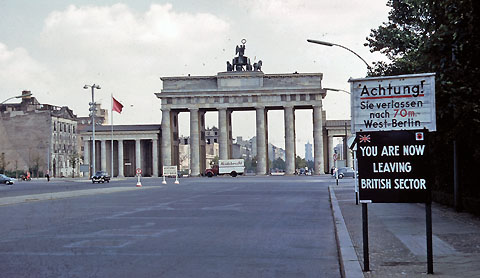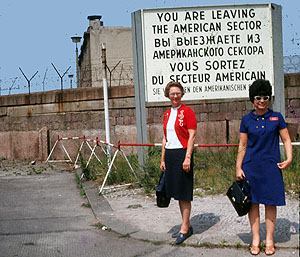HIS 102
Unit 14: Cold War

This
is a photo of
the Berlin Wall before it was a wall in 1959, looking at the
Brandenburg Gate (Brandenburger Tor) which was the end point of the
main avenue in Berlin (Unter den Linden). The gate became the
symbolic dividing point between East and West Berlin when the "wall"
was built in 1961. Below is a
photo of the wall--sorry that the slide is a little dirty--after it was
a "wall" in 1967.

 What you
must do in this unit
What you can do in this unit
What you
must do in this unit
What you can do in this unit
- Read Aleksandr Solzhenitsyn, One Day in the Life of Ivan Denisovich (if you are going to submit the optional Solzhenitsyn paper).
- Submit the
Optional Solzhenitsyn paper. If you don't understand why I call this an optional paper, take a look at the Explanation of Assignments and Grading
- Submit a My Family and History
paper that requires you to examine your family's history in light of
the historical events of the past half century. Point value is
100 points possible for a two-page paper (less for one page).
- Listen to some further information about this unit
as a mp3 file. You can also read the information as
a txt file.
Some videos that you can watch for this unit
Extra Credit Options
- Take the short 5-point quizzes for chapters 27 and 28. Log into Blackboard and look under "Chapter Quizzes." You have five minutes to complete each quiz (multiple-choice questions).Read George Kennan's
"The Sources of Soviet Conduct". In
a one-page paper, given the benefit of hindsight, assess the accuracy of Kennan's
remarks almost fifty years later for a maximum of 50 points extra credit.
- Watch the movie Dr. Strangelove, or How I Learned to Stop Worrying and Love the Bomb
(1964, directed by Stanley Kubrick), released at the very height of the
Cold War. For a maximum of 25 points, in a long paragraph explain
why or why not a similar-type of movie poking fun at the current
international situation could be released in 2006.
- For 25 points maximum extra credit, compare and contrast the NATO and
Warsaw pact treaties in a short
paragraph.
- For a maximum of 25 points extra credit, read The Helsinki
Final Act (1975) and write a short paragraph explaining the purpose of the Accords.
- For a maximum of 50 points extra credit, read Winston Churchill's Iron Curtain
Speech (1946) and then Joseph Stalin's Reply to Churchill (1946) and write a one-page paper comparing the rhetoric on both sides.
- For a maximum of 25 points extra credit, read the U.S. and USSR Exchange of Notes on the Berlin Wall
(1961) and write a paragraph on the politics involved in the creation of the Berlin Wall.
- For a maximum of 50 points extra credit, read the The Tonkin Bay Resolution (1964), and then write a one-page paper, How did the Gulf of Tonkin Incident provide an excuse for United States military involvement
in Vietnam?
- For a maximum of 10 points extra credit, answer the Solzhenitsyn
study sheet
questions.
- For a maximum of 50 points, choose one of the famous quotes about the study of history--scroll down that page to find a list of quotes--(Get permission from your instructor first.) and write a one-page paper in which you explain who the author of the quote was, what he/she meant by the quote and then your evaluation of the quote's acuracy. (You can also use the material on these two links, Historians and Why we study history). Don't forget to cite your sources.
- For 25 points of extra credit, contribute at least five photos to the Northern Virginia Digital History Archive.
- For extra credit, please suggest a
relevant website for this unit of the course. Send the title of the site, the url and a
brief explanation why you find the information interesting and applicable to
the material being studied this unit.
|


